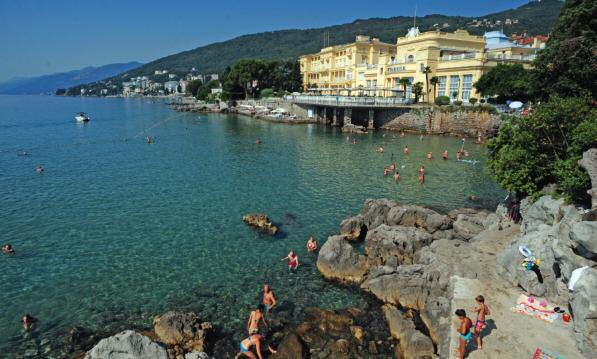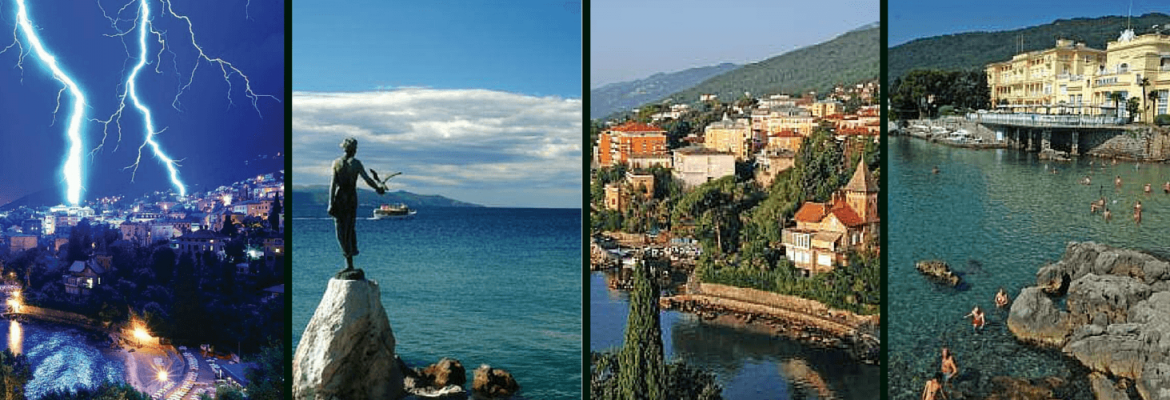ALL THAT was missing were a few white suits, panama hats, parasols, elegant long dresses and a scattering of hussars in officer’s uniform, and the scene could have been 120 years earlier at the zenith of the Austro-Hungarian empire.
Sitting on the terrace enjoying a Sunday morning coffee and watching the world stroll by through the immaculate gardens and down the promenade alongside a flat calm, crystal clear Adriatic, I could easily imagine those days.
The pastel colours of the stately hotels remain, the trees in the park have matured and now offer more shade but the view over to the hazy islands of the Gulf of Kvarner hasn’t changed.
Clean sea air, a languid, peaceful feel and that lovely syrupy warmth… It wasn’t difficult to see why royalty and the other great and good of the empire decided to turn the Croatian town and the villages along the coast into the Opatija Riviera.
Emperor Franz Joseph, German Kaiser Wilhelm and the Swedish-Norwegian King Oscar II led a procession of composers, artists, actors and personalities of the day like Isadora Duncan to Opatija around the turn of the 20th century.

My coffee was served on the terrace of the famous Kvarner Hotel. You might recognise it from the Eurovision song contest. The Croatian votes are usually broadcast from a party in the fabulous Crystal Hall of the hotel.
By now it was heating up, and down in the little bays and rocky inlets the sunbathers were taking to the clear, warm waters. There was a lot more flesh on display than in the 1890s – all very respectable for 2013, but enough to have had Franz Joseph’s famous whiskers bristling.
The Riviera’s main resorts – Volosko, Opatija, Icici, Ika and Lovran – are connected by the Lungomare, a 12-kilometre (7.5-mile) promenade that winds around the jagged coast. Built between 1889 and 1911, it is now lit and is a flat, comfortable walk especially in the evening or early morning. You can make your walk as long or short as you’d like and there’s a good bus service if you just want to walk one way.
It was pretty hot when we were in Opatija at the height of summer so, after strolling along most of the town section of the path from our hotel, we took a bus to Lovran and walked from the outskirts on the Lungomare along to the harbour and then into the narrow streets of the old town.
Many of the villas on the way have been bought and restored by Europe’s nouveau riche. We called in at the Villa Astra, a sixbedroom boutique hotel with health spa which has been restored by a local businessman Vjekoslav Martinko. The next-door Villa Nova was just getting the finishing touches by the same owner.
Lovran grew from a fishing port in the Middle Ages and its many little restaurants still specialise in the fruits of the sea. We walked up through the little lanes for lunch at the excellent Knezgrad restaurant before meeting a good friend of Choice, the travel writer and expert on Croatia, Julia Berg, who was spending most of the summer in an apartment in Lovran. Julia has shared her favourite secrets of Croatia on these pages.
In Opatija we were staying at the Hotel Ambasador, a modern resort hotel overlooking a wide bay with sheltered swimming and sunbathing.
Our balcony rooms gave a superb view of the Gulf of Kvarner and the harbour and then the heart of the town, as well as across to the islands and back to the city of Rijeka. We also got an unexpected and spectacular lightning show one evening. Perfect holiday conditions resumed by the morning.
Don’t Miss
Deep down in the sea, off the coast of Krk island, an excellent sparkling wine is made, called Valomet. It’s true – the darkness and the quiet make the Zlahtina wine into something special. With respect to the French, we would call it ‘Kvarner Sea Champagne’. Fermentation takes place in the bottles which, when raised from the sea, are usually naturally decorated with beautiful corals and shells

